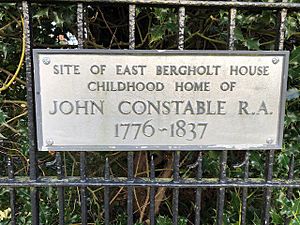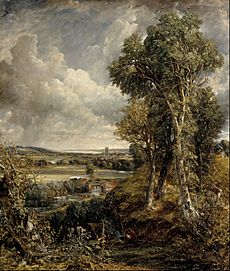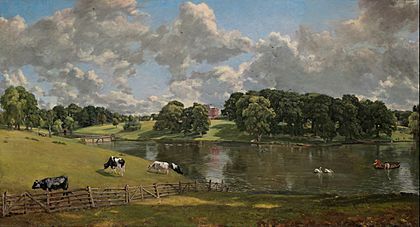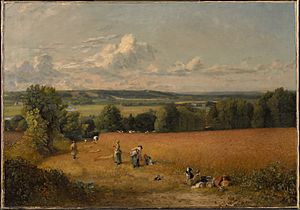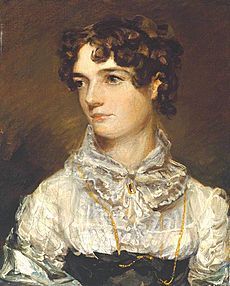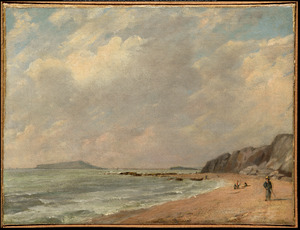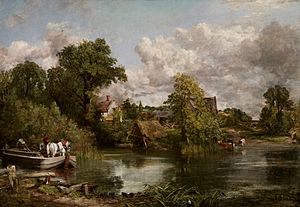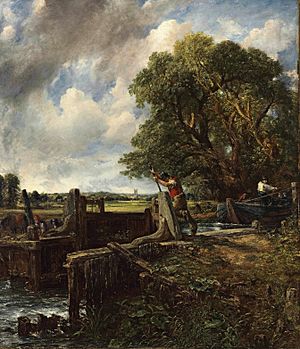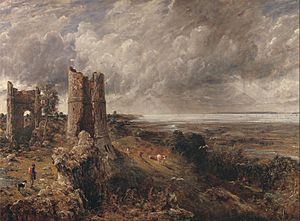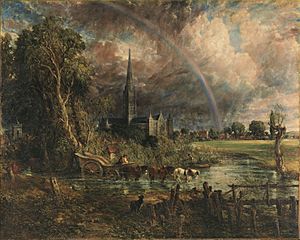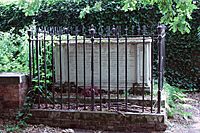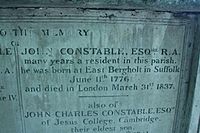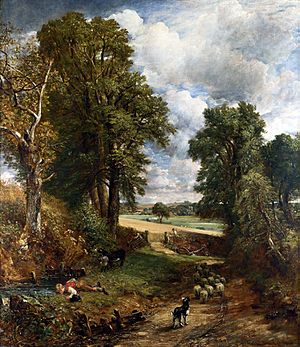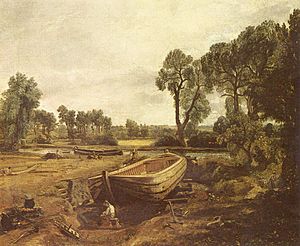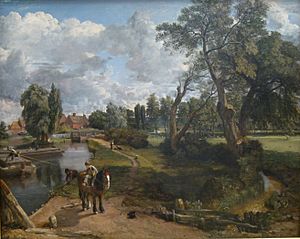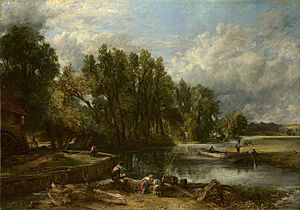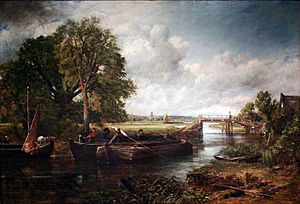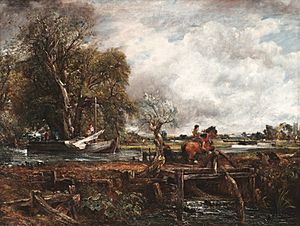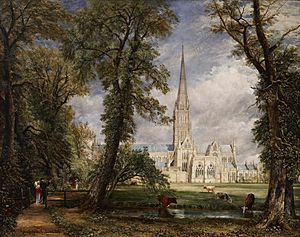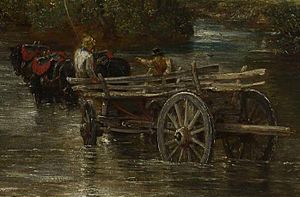John Constable facts for kids
Quick facts for kids
John Constable
|
|
|---|---|
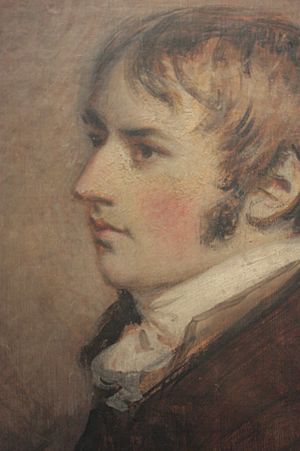
John Constable by Daniel Gardner, 1796
|
|
| Born | 11 June 1776 East Bergholt, Suffolk, England
|
| Died | 31 March 1837 (aged 60) London, England
|
| Resting place | St John-at-Hampstead, London |
| Nationality | British |
| Known for | Landscape painting |
|
Notable work
|
The Hay Wain Dedham Vale |
| Movement | Romanticism |
John Constable (born 11 June 1776 – died 31 March 1837) was a famous English landscape painter. He was part of the Romantic art movement.
Constable was born in Suffolk, England. He changed how people saw landscape painting. He was especially known for his paintings of Dedham Vale. This area around his home is now called "Constable Country." He loved this place very much. He once wrote, "I should paint my own places best." He also said, "painting is but another word for feeling."
Some of Constable's most famous paintings are Wivenhoe Park (1816), Dedham Vale (1821), and The Hay Wain (1821). Even though his paintings are now very popular and valuable, he was not rich during his lifetime. He became a member of the Royal Academy of Arts when he was 52. His art was very popular in France. He sold more paintings there than in England. His work even inspired the Barbizon school of painters in France.
Contents
John Constable's Early Life and Art
John Constable was born in East Bergholt. This village is by the River Stour in Suffolk. His parents were Golding and Ann Constable. His father was a wealthy corn merchant. He owned Flatford Mill and later Dedham Mill. John was expected to take over the family business. But his younger brother Abram took over the mills instead.
When he was young, Constable loved to sketch. He drew scenes from the Suffolk and Essex countryside. These places later became the main subjects of his art. He said these scenes "made me a painter." He loved "the sound of water escaping from mill dams," and "willows, old rotten planks, slimy posts, and brickwork."
He met George Beaumont, an art collector. Beaumont showed him a painting by Claude Lorrain, which inspired Constable. Later, he met the artist John Thomas Smith. Smith gave him painting advice. But he also told Constable to stay in his father's business.
Becoming a Professional Artist
In 1799, Constable convinced his father to let him become an artist. His father gave him a small amount of money. Constable joined the Royal Academy Schools. He took classes and studied famous artworks. He was inspired by painters like Thomas Gainsborough and Claude Lorrain.
In 1802, he turned down a job teaching drawing. He wanted to be a landscape painter. He wrote that he wanted to "represent nature" truthfully. He felt there was "room enough for a natural painter." He believed artists should not just copy others.
Constable's early paintings showed fresh light and color. They also showed the influence of older artists. But his usual subjects, like everyday country scenes, were not popular then. People preferred wild landscapes or ruins.
By 1803, he was showing his paintings at the Royal Academy. In 1806, he visited the Lake District. But he found the mountains too lonely. He preferred scenes with people, like "villages, churches, farmhouses and cottages."
Constable usually spent winters in London. He painted in East Bergholt during the summers. In 1811, he visited John Fisher in Salisbury. The cathedral and landscape there inspired some of his best paintings.
To earn money, Constable also painted portraits. He found this boring, but he did many good ones. He also painted some religious pictures.
Painting Country Houses
Another way he earned money was by painting country houses. In 1816, he painted Wivenhoe Park, Essex for Major-General Francis Slater Rebow. He also painted a smaller picture of a fishing lodge. Constable used the money from these jobs for his wedding. This time in his life was filled with detailed paintings of beautiful country scenes, like The Wheat Field (1816).
Marriage and New Art Styles
Since 1809, Constable had been in love with Maria Elizabeth Bicknell. They had been friends since childhood. They got married in 1816. Constable was 40 years old. Maria's grandfather did not approve. He thought the Constables were not important enough. Maria's father also worried she would lose her inheritance. Constable's parents approved, but they would not support the marriage financially. After his parents died, Constable inherited some money from the family business.
John and Maria got married in October 1816. They spent their honeymoon on the south coast. The sea at Weymouth and Brighton inspired Constable. He started using brighter colors and livelier brushstrokes. His art also began to show more emotion. During his honeymoon, Constable started painting grander nature scenes. These often featured dramatic skies, like Osmington Bay.
Before his marriage, Constable started his most ambitious painting. He wrote to Maria that he was working on a "large picture." This painting was Flatford Mill (Scene on a Navigable River). It was his biggest painting of a working scene on the River Stour. He painted most of it outdoors. He wanted to paint on a larger scale to get more attention. He also wanted to show his ideas about landscape painting. Flatford Mill did not sell at first. But it was praised for its detail. This encouraged Constable to paint even larger pictures.
Constable struggled to earn money from his art. But in 1819, he sold his first major painting, The White Horse. This painting was very important for him. It sold for a good price to his friend John Fisher. This gave Constable some financial freedom.
The success of The White Horse helped him become an associate of the Royal Academy of Arts. It also led to a series of six huge landscape paintings. These paintings showed scenes from the River Stour. They are called the 'six-footers' because of their large size. Their size helped Constable get noticed at art exhibitions. Many people think these are his most important works.
This series includes:
- Stratford Mill (1820)
- The Hay Wain (1821)
- View on the Stour near Dedham (1822)
- The Lock (1824)
- The Leaping Horse (1825)
Famous Works and French Success
In 1820, his second six-footer, Stratford Mill, was shown. Critics said it looked "more exact of nature" than any other English painting. It was also a success. John Fisher bought it for his friend, John Pern Tinney. Tinney loved the painting so much he offered Constable more money for another one.
In 1821, Constable's most famous painting, The Hay Wain, was shown. It did not sell in England at first. But two Frenchmen saw it: the artist Théodore Géricault and writer Charles Nodier. Géricault was "quite stunned" by it. Nodier suggested French artists should learn from nature, like Constable.
In 1824, an art dealer bought The Hay Wain and View on the Stour near Dedham. He showed them at the Paris Salon. They were a huge hit! The Hay Wain even won a gold medal. The painter Eugène Delacroix was very impressed by Constable's colors. He even repainted part of his own painting after seeing Constable's work.
The Lock was shown in 1824. It sold on the first day of the exhibition. This was the only time a Constable painting sold so quickly. The Lock is the only upright painting in the Stour series. Constable painted more than one version of it. His last six-footer, The Leaping Horse, did not sell during his lifetime.
Constable's Later Life
Constable's happiness was cut short. His wife, Maria, became ill with tuberculosis. From 1824 to 1828, Constable moved his family to Brighton. He hoped the sea air would help Maria. During this time, Constable painted coastal scenes instead of large River Stour scenes. He was not sure if Brighton was a good subject for painting. He wrote that the "magnificence of the sea" was lost in the "din" of coaches and people.
Constable sold only 20 paintings in England during his life. But he sold more than 20 in France in just a few years. Still, he refused to travel abroad to promote his art. He said he would "rather be a poor man [in England] than a rich man abroad."
In 1825, he had an argument with his French art dealer. This might have been due to worry about his wife's health. He lost his way to sell art in France.
Chain Pier, Brighton was his only big painting of Brighton. It was shown in 1827. The Constables stayed in Brighton for five years. But Maria's health did not improve. After their seventh child was born in 1828, they moved back to Hampstead. Maria died there on 23 November, at age 41. Constable was heartbroken. He wrote that "the face of the World is totally changed to me."
After Maria's death, Constable wore black clothes. He was often sad and worried. He raised his seven children alone for the rest of his life. Some of his children also painted, like his son Lionel.
Maria's father also died before her. He left her £20,000. Constable tried to invest this money, but he lost it. He tried to publish prints of his landscapes. But he struggled with the engraver and could not find enough people to buy them.
During this sad time, his art changed. It became more broken and expressive. His later masterpieces, Hadleigh Castle (1829) and Salisbury Cathedral from the Meadows (1831), show his deep feelings.
He was elected to the Royal Academy of Arts in February 1829, when he was 52. In 1831, he became a Visitor at the Royal Academy. Students seemed to like him.
He also gave public talks about landscape painting. He said that landscape painting is both scientific and poetic. He believed that imagination alone cannot create art as good as reality. He also said that no great painter ever taught themselves.
He also spoke against the new Gothic Revival style. He thought it was just copying old styles.
In 1835, he gave his last talk to students. He praised the Royal Academy as the "cradle of British art." He died on 31 March 1837, likely from heart failure. He was buried with Maria in the churchyard of St John-at-Hampstead Church in Hampstead, London. His children John Charles and Charles Golding Constable are also buried there.
Places Connected to Constable
Bridge Cottage is a place you can visit. It is owned by the National Trust. Nearby, Flatford Mill and Willy Lott's Cottage (seen in The Hay Wain) are used for nature courses. The biggest collection of Constable's original paintings outside London is at Christchurch Mansion in Ipswich. Somerville College, Oxford also has a portrait by Constable.
Constable's Art Style
Constable did not like the idea that artists should only use their imagination. He believed they should paint what they saw in nature. He told his friend, "When I sit down to make a sketch from nature, the first thing I try to do is to forget that I have ever seen a picture."
Constable felt his talent came from the River Stour area. But some say his artistic growth was also helped by his relative, Thomas Allen, and the people Allen introduced him to in London.
Constable always painted studies directly from nature. He never just followed a set way of painting. He wrote, "The world is wide... no two days are alike." He believed that true art, like nature, is always unique.
Oil Sketches and Watercolors
Constable made many large oil sketches before his finished paintings. These sketches were very new for his time. They had free and strong brushstrokes. They still interest artists and art lovers today. For example, the oil sketches for The Leaping Horse and The Hay Wain are full of energy. This energy is sometimes less obvious in his finished paintings. These sketches show that Constable was an avant-garde (ahead of his time) painter. He showed that landscape painting could go in a new direction.
Constable's watercolors were also very free. His painting Stonehenge (1835), with its double rainbow, is considered one of the greatest watercolors ever. When he showed it, he wrote about the "mysterious monument of Stonehenge." He said it takes you back to a "totally unknown period."
He also made many studies of landscapes and clouds. He wanted to be more scientific in showing weather. His paintings sometimes made people feel the weather. For example, a critic said The Chain Pier (1827) had an atmosphere that "almost imparts the wish for an umbrella."
His sketches were some of the first oil paintings done outdoors. To show light and movement, Constable used broken brushstrokes. He would often rub paint over lighter areas. This made his paintings look like sparkling light was everywhere. One powerful study is Seascape Study with Rain Cloud (around 1824). It shows a sudden rain shower at sea with strong, dark brushstrokes. Constable also painted rainbows, like in Salisbury Cathedral from the Meadows (1831).
He wrote notes on his sky studies. He noted the weather, light, and time of day. He believed the sky was the "key note" and "chief organ of sentiment" in a landscape. He was influenced by meteorologist Luke Howard, who classified clouds. Constable wrote, "I have done a good deal of skying... I am determined to conquer all difficulties."
Constable once wrote that his art could be found "under every hedge, and in every lane." He never knew how much his honest style would influence others. His art inspired artists like Géricault and Delacroix. It also influenced the Barbizon School and the French Impressionists later on.
In 2019, two of Constable's drawings were found in a box. They sold for a lot of money at an auction.
Gallery
Selected Paintings
- The Hay Wain (1821)
- The Vale of Dedham (1828)
- Salisbury Cathedral from the Meadows (1831)
- Stonehenge (1835)
See also
 In Spanish: John Constable para niños
In Spanish: John Constable para niños



